I had been keen on taking a vacation in March, which is one of the best times to visit quite a few national parks in India. Sightings are better in the blazing hot summer months of April and May when waterholes tend to dry up, but March has the advantage of a relatively pleasant climate coupled with markedly lesser crowds of Indian family tourists with noisy kids (most schools have their exams in the month of March).
My journey started with Corbett – a 6-hour drive from Delhi, and I would subsequently travel to Kaziranga in east India and my perennial favourite, Kanha National Park in Central India.
Jim Corbett National Park – popularly referred to as Corbett – is nestled in the foothills of the Himalayas in the districts of Nainital, Almora and Pauri Garhwal. An earlier visit to the Park in December 2005 when I stayed in one of the plush resorts in Ramnagar, infested with noisy, picnicking families had convinced me that if one was to enjoy Corbett, one had to stay in the forest rest house at Dhikala. While in my earlier trip, I had fled Corbett after one trip into the Park in the Bijrani range (the Park is located in breathtakingly scenic surroundings with the Ramganga river passing through the Park but the Ramnagar side gets very touristy), this time I was going to stay in the forest rest houses at Dhikala and Gairal for 1 night each. After my earlier experience, I had gone to Corbett with very low expectations – but somehow the jungle has this habit of conjuring up miracles when they are least expected.
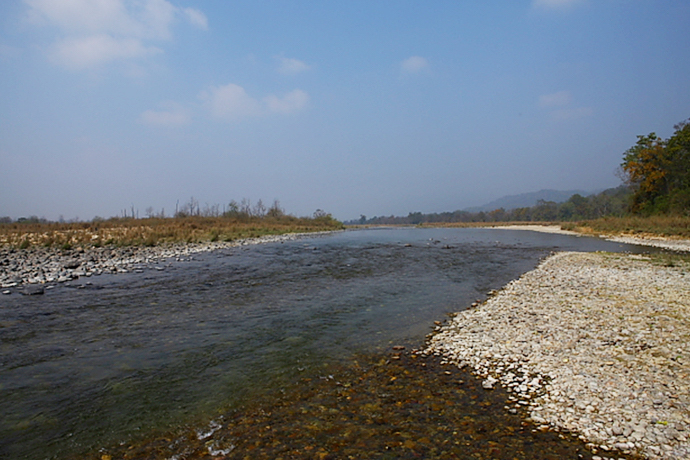
Canon EOS 1Ds Mark III with 24-70 mm f 2.8 L USM lens @ 24 mm; f 9.0 and 1/400 sec
5 March 2008 evening
On the evening of 5 March, barely 15 minutes into the drive, we encountered a young tusker in a playful mood, busy wallowing in a pool of mud – he seemed oblivious to the 8 odd jeeps loaded with excited tourists which had gathered on the ridge road overlooking his mud bath.
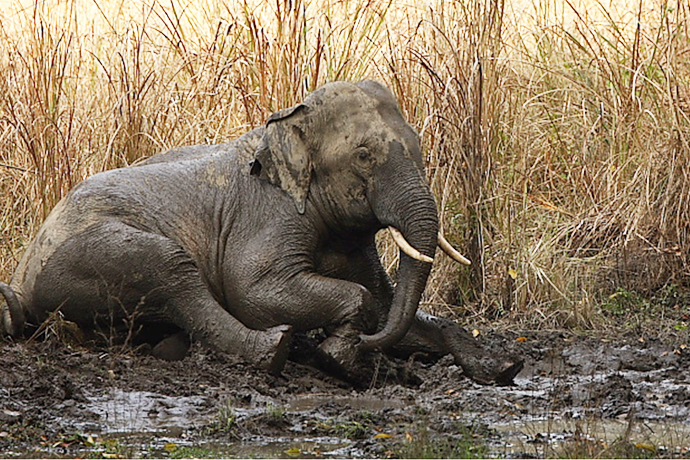
Canon EOS 1Ds Mark III with 100-400mm f/4.5-5.6 L IS USM lens @ 310 mm ; f 5.6 and 1/125 sec
The first evening had more in store – as we were driving around (the driver was a very knowledgeable Sardarji called Kale Kohli), we heard an alarm call of a langur. There was one more vehicle parked on the road – evidently, they had heard the calls too. We stopped a small distance away from them – there was an elephant herd on one side of the road behind dense undergrowth and we could hear another elephant on the opposite side, which seemed hell-bent on destroying as much of the jungle as he could. Suddenly while we were still waiting, an elephant sprinted across the road trumpeting loudly. He seemed scared by something while a langur started to give more urgent alarm calls. The atmosphere became electric, as there was definitely a tiger around. All of us stood absolutely still – my camera was all ready, should the tiger emerge out of the undergrowth. After around 15 minutes of waiting expectantly, we resigned ourselves to having been fooled by a false alarm when the elephant emerged again. He came close to us, giving us a onceover and disappeared into the undergrowth to resume his ruckus.
There was evidently something going on between him and the tiger. Just as we began to lose hope and when I had tucked my camera away, a tiger burst out of the undergrowth and ran across the road to the opposite side, where the herd of elephants was. The herd of elephants immediately closed ranks with loud trumpeting noises to protect the calves as the tiger slunk away. Although I couldn’t photograph the tiger, (by the time, my eyes and mind screamed “TIGER! GET THE CAMERA OUT!” to my hands, the tiger was gone) this was one of my most memorable tiger sightings.) I was happy that I had seen the tiger in Corbett and that too after a fair bit of drama.
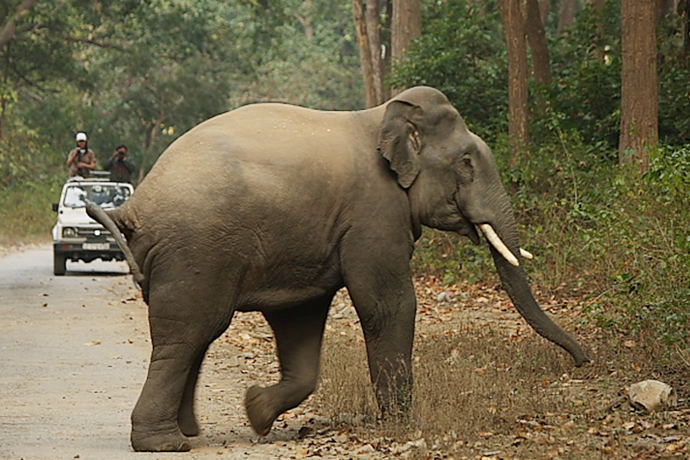
Canon EOS 1D Mark III with 100-400 mm f/4.5-5.6 L IS USM @ 210 mm; f 5.0 and 1/60 sec
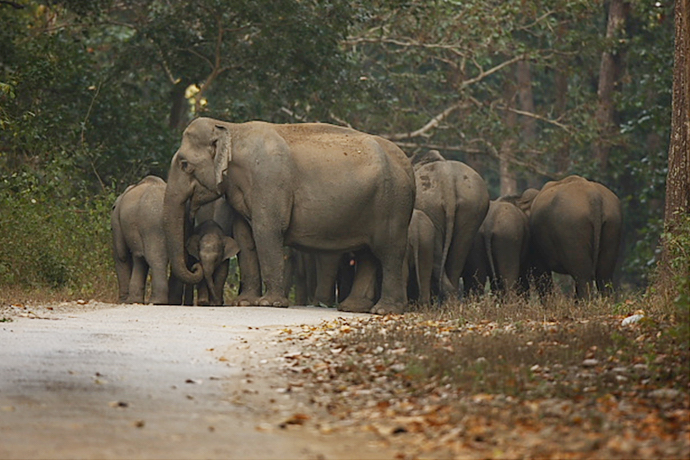
Canon EOS 1Ds Mark III with 600 mm f4 L IS USM lens; f 5.0 and 1/40 sec
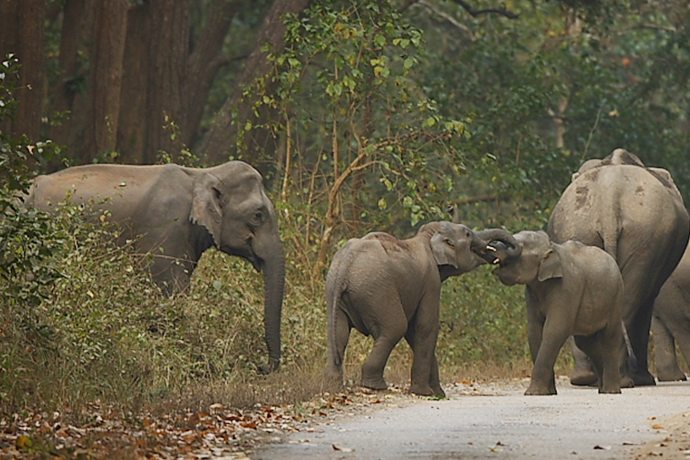
Canon EOS 1Ds Mark III, 600mm f/4.0 L IS USM lens; f 5.0 and 1/60 sec
6th March 2008
The morning of 6th March began with the sighting of another tusker making his way across the mist-covered grasslands of the Dhikala range. These grassy pastures called as chaurs represent roughly 10% of the core area and make ideal grazing land for Corbett’s population of wild elephants.
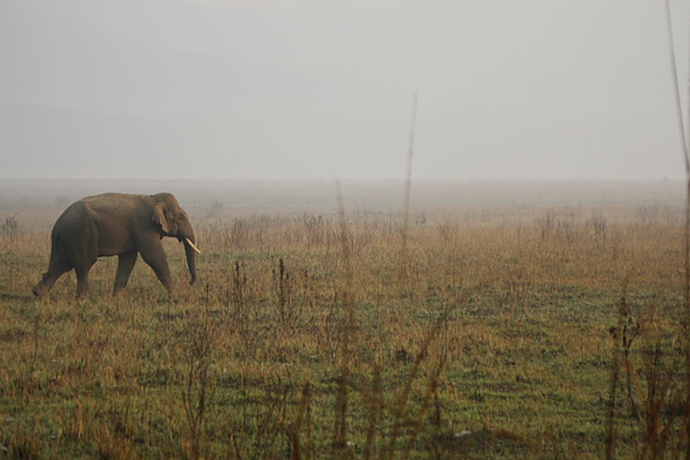
Canon EOS 1D Mark III with 100-400 mm f / 4.0 -5.6 L IS USM lens @ 105 mm; f 4.5 and 1/400 sec
Later on in the morning, I had my first sighting of a nightjar (which lay camouflaged like a dry leaf on the road) and a juvenile Cinereous Vulture – a globally threatened species. While Kale insisted that it was a Himalayan Griffon vulture, the more I studied it through the 1200 mm telephoto lens attached to my camera, the more I was convinced that it was a juvenile Cinereous and not a Himalayan Griffon.
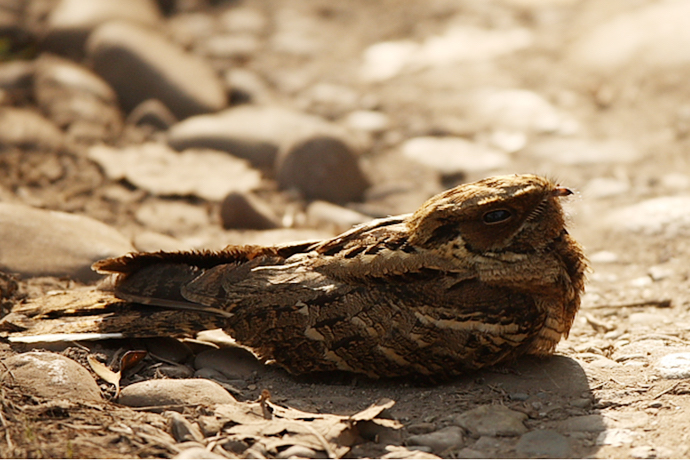
Canon EOS 1Ds Mark III with 600 mm f/4.0 L IS USM lens; f/4.0 and 1/1250 sec
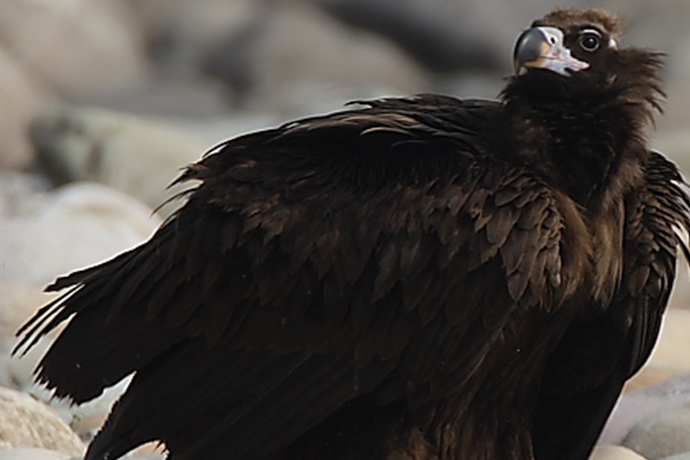
Canon EOS 1D Mark III with 600mm f4 L IS USM lens with 2X teleconverter; f 8.0 and 1/250 sec
The evening ride of 6th March gave me my first photographs of a tiger in Corbett. Once again, there a langur gave out alarm calls from a tree. Around 10 jeep-loads of tourists clustered within 25 meters of each other, waiting for a glimpse of the object of the langur’s consternation.
Kale – in what turned out to be a decision of unparalleled acumen – said that we should go slightly ahead and wait from where we could watch the langur which was giving out alarm calls. So I looked for the langur through the binoculars. Just as I was saying that the langur was looking down and to the right (all the 10 jeeploads were looking left), Kale said in a very matter-of-fact voice “There it is”. To put things into context, such is the tiger’s charisma that whenever a tiger is spotted, from the heightened levels of excitement in the spotter’s voice one instinctively turns around with a “OMG-show me where” expression. So when Kale said, “There it is” in a matter-of-fact tone, I thought that he was referring to the langur. Then he said “Sahib – Tiger!” and my eyes followed the direction he had indicated while my hands hoisted the camera onto the tripod. The tiger was sitting camouflaged behind a bush and was watching all the jeeps – once again reminding me of “For every one time you see a tiger, the tiger has seen you a thousand times before”. We signaled to all the other jeeps and as everyone saw the tiger I could sense the feeling of “mission accomplished” which pervaded the entire atmosphere.
7th March 2008 morning
Two tiger sightings in two days in a Park where it is not so easy to see the tiger! So, on the morning of 7th March, I was more keen on birds and watched tree tops for them when our driver (Kale had gone back home) whispered urgently “Tiger!”. The tiger was right in the middle of the road clearing his stomach. By the time the jeep came to a halt and my camera was out, the tiger was covering his droppings with dust and dry leaves and then walked along the road towards us for around 10 meters before disappearing into the undergrowth.
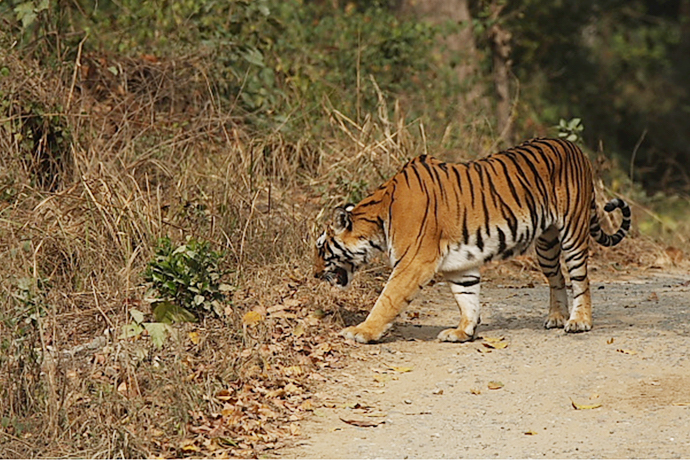
Canon EOS 1D Mark III with 600 mm f/4.0 L IS USM lens; f 9.0 and 1/125 sec
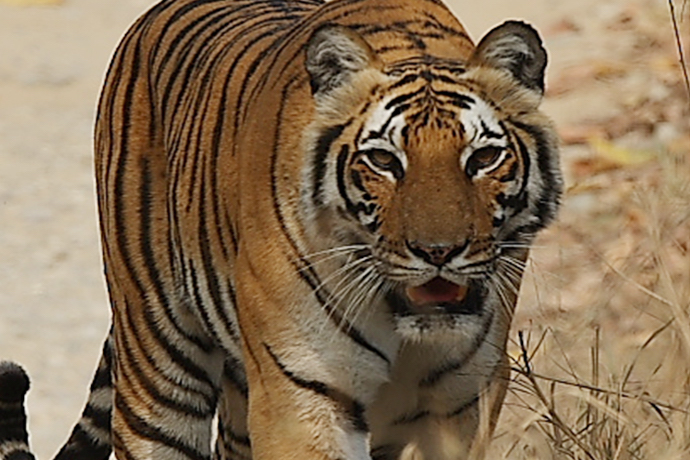
Canon EOS 1D Mark III with 600mm f/4.0 L IS USM lens ; f 9.0 and 1/125 sec
The morning had more in store for us – while we were parked on a wooden bridge across the Ramganga river, a pied kingfisher and crested kingfisher almost posed for the camera. It was my first sighting of a crested kingfisher. The best part was that this one was not in the least bit shy.
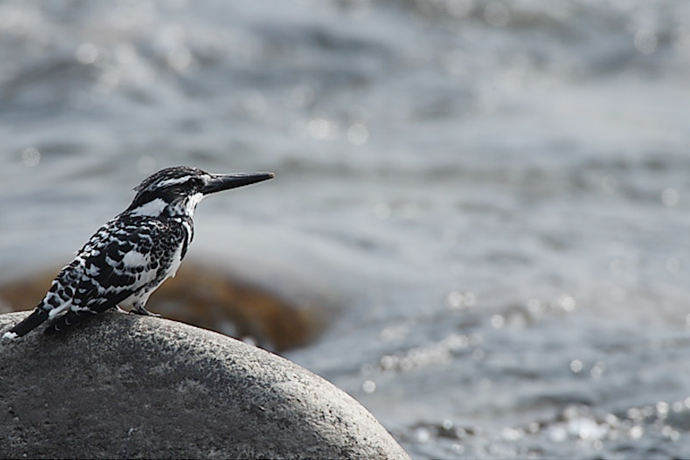
Canon EOS 1D Mark III with 600 mm f/4.0 L IS USM lens with 2X teleconverter; f 9.0 & 1/125 sec
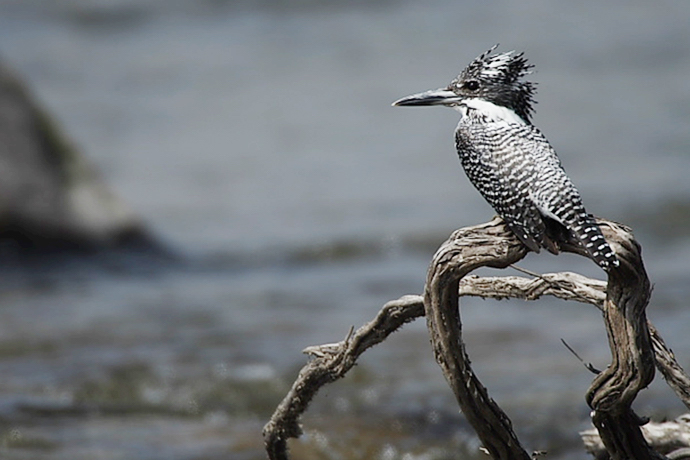
Canon EOS 1D Mark III with 600 mm f/4.0 L IS USM lens with 2X teleconverter; f 8.0 and 1/400 sec
The evening ride rewarded me with my first sighting of a whole flock of Kalij pheasants which are very uncommon – they crossed the road within 10 meters of our stationary jeep.
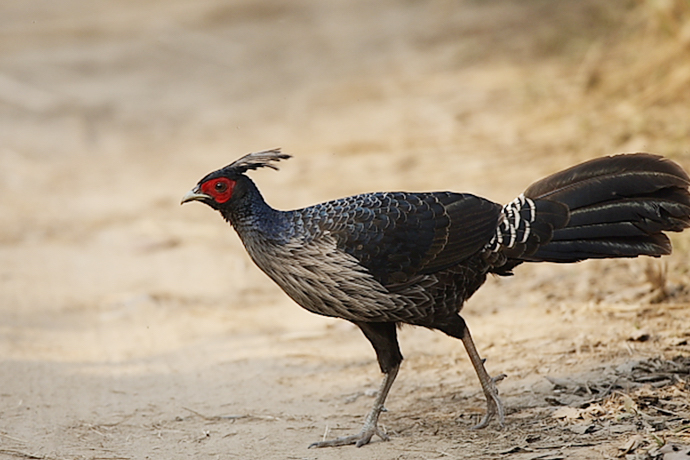
Canon EOS 1D Mark III with 600 mm f/4.0 L IS USM lens; f 4.5 and 1/250 sec
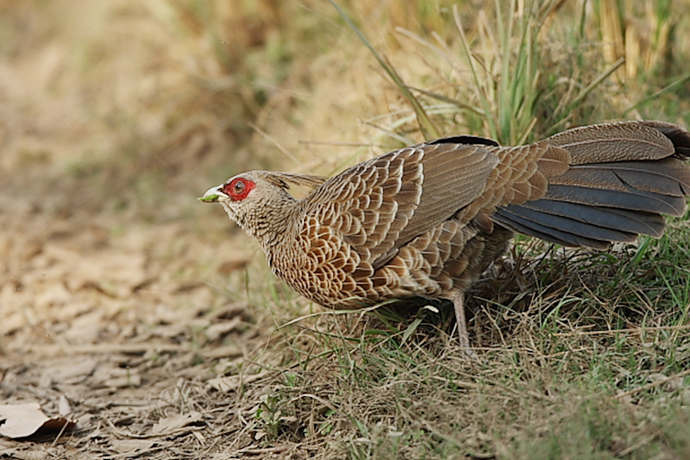
Canon EOS 1D Mark III with 600 mm f/4.0 L IS USM lens; f 4.5 and 1/125 sec
